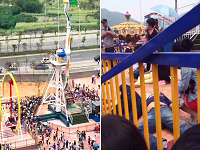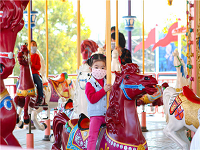How About The Chinese Amusement Equipment Status?
The emergence and development of amusement equipment in China started relatively late. And large-scale modern amusement equipment began to appear in the 1980s. In 1980, Japan’s Toho Entertainment Co., Ltd. presented a “Moon Landing Rocket” to China. And it was installed in Beijing’s Zhongshan Park. This is the first large-scale modern amusement equipment in China. It is a mark that China has an amusement equipment in the true sense.
The foreign amusement equipment and the expectation of Chinese people for amusement facilities promoted the emergence of the first batch of scientific researchers interested in amusement equipment in China. In 1980, a group of scientific research and design personnel from Beijing General Institute of Nonferrous Metallurgy Design and Research began to devote themselves to the design of amusement equipment.
They developed and designed moon landing rockets, dragons and water, automatic control planes, carousel, flying elephants, and aerial swivel chairs. , overhead monorail, double flying, sliding dragon, rolling roller coaster and other dozens of modern amusement equipment. That filled the gap in the design and manufacture of China amusement equipment, and made outstanding contributions to the birth and development of China amusement industry.
In 1981, the first batch of modern large-scale amusement equipment designed and manufactured by my country was first installed in Daqing Children’s Park. It was warmly welcomed by tourists, especially teenagers and children. The design, manufacture and use of China amusement equipment were unveiled.
With the continuous deepening of reform and opening up and the rapid development of the economy, China’s amusement parks (fields) have gradually emerged. Beijing, Tianjin, Shanghai and Guangdong have successively invested or jointly built a large number of amusement parks.
The larger ones include “Changjiang Amusement Park” in Zhongshan City, Guangdong, “Oriental Amusement Park” in Guangzhou, “International Amusement Park” in Beijing Miyun, and “Jinjiang Amusement Park” in Shanghai. These amusement parks have introduced a number of foreign amusement equipment. It provided a rare opportunity for learning and reference for the design and manufacturing units of amusement equipment in my China.
Since then, the amusement industry has entered a period of rapid development. It has greatly enriched people’s entertainment life, cultivated people’s sentiments, beautified the urban environment, and promoted the construction of socialist spiritual civilization. Today, Suzhou Amusement Park, Shenzhen Happy Valley, Guilin Happy Valley, Guangdong Chimelong Happy World (Panyu), etc.
have become the leaders of my country’s theme parks. Statistics show that there are about 40 theme parks that have opened or are under construction in 2015 and 2016 alone. Major projects opened in 2015 include Hello Kitty theme park in Anji, Zhejiang, Fantawild Oriental painting park in Anhui and Shandong, etc. , and in 2016, Shanghai Disneyland and Wanda theme parks around the world have also opened parks one after another.
It is estimated that by 2020, a total of 64 large-scale theme parks will be constructed and operated. At present, more than 2,800 theme park-style tourist spots have been developed nationwide, more than 70 times the number developed in the United States in the past 60 years.
At present, there are various types of theme parks in my China. It includes various forest parks, animal and botanical gardens, geological parks, hot spring parks, cultural parks, ocean parks, water parks, historical and cultural parks, etc. China theme parks basically have a three-level ladder structure:
The eastern coastal area is more distributed and larger in scale, the central area is less distributed and small in scale, and the western area is less distributed and smaller in scale.
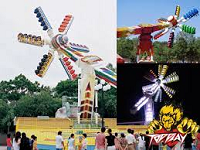
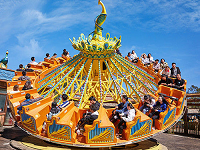

At present, Chinese national theme parks can be roughly divided into seven categories according to the theme:
1) With the theme of traditional Chinese national culture, such as Shenzhen Splendid China, Kunming Yunnan Ethnic Village, etc.
2) With the theme of animal viewing, such as Guangzhou Panyu Xiangjiang Wildlife Park, Chimelong Night Animal World, etc.
3) The theme of literary and cultural heritage, such as Beijing Grand View Garden, Wuxi Three Kingdoms City, etc.
4) The theme of film and television culture, such as Guangdong Nanhai Film and Television City, Wuxi Tangcheng, etc.
5) The theme of exotic culture, such as Shenzhen Window of the World, Beijing World Park, etc.
6) With the theme of science, science fiction, joy, etc., such as Shenzhen Happy Valley, Dalian Aquarium, etc.
7) With water as the theme, such as water cube, water cube, etc.
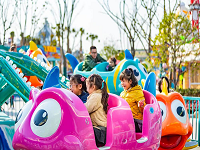
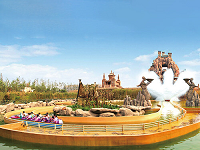

Characteristics of Chinese theme parks
1) The development process is relatively short. In the early 1980s, theme parks began to enter Chinese tourism industry. It has only been about 20 years, and the grasp of product and industry characteristics and the accumulation of experience are far from enough.
2) For a long period of time, China’s theme park industry, like other enterprises, has different degrees of unclear property rights and unsound operation and management. It was not until the mid-to-late 1990s that a number of non-state-owned capital investment projects appeared.
3) Compared with the mature development of foreign theme parks, many theme park products in China are relatively backward in terms of management concepts and systems.
It is mainly manifested in the lack of innovative awareness and ability of operators in the selection and shaping of themes, brand building, marketing, service management, and human resource development. This leads to problems such as the disconnection between scale and operation, very limited profitability, and low comprehensive income.
With the rapid development of China’s economy and the continuous improvement of people’s living standards, people’s needs for amusement have been stimulated. Indulging in a theme park with peculiar equipment represents a novel experience.
China’s theme parks will continue to flourish in the years to come. In the future, as international amusement giants enter the Asian market, the competition in the theme park industry in this region will become extremely fierce.
Theme parks are showing a trend of integration and development with cultural industries, real estate, accommodation, vacation and recuperation, commerce and other industries. Large-scale, high-quality and branded theme parks will be more popular among tourists, and innovative experiences brought by technology will Competitive landscape of leading industries.
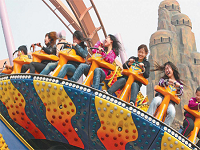

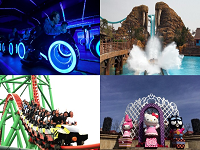
The business model of theme parks
From the perspective of the business model of Chinese theme parks, there are mainly five models: Disney model, OCT model, Wu Culture Park model, Water Culture model and Fifth Pole model.
(1) Disney model Disney has a slogan called “Disney that can never be built”, and has always adopted the “three-three system” in business projects. Every year, 1/3 of the hardware equipment is eliminated and 1/3 of the new concept is built. The project keeps giving visitors a sense of freshness.
In terms of profitability, Disney is diversified. Including food, housing, transportation, travel, shopping, and entertainment, the industrial chain consisting of movies, daily necessities, audio-visual, books, food, computer games and other industries is creating a steady stream of business opportunities for Disney and adding capital to culture.
Create a “lucid dream”, develop a series of products around this dream, and then promote it to the society in the name of culture. This is Disney’s business ecological chain.
The entry of Disney, redefines the standard of theme park management services. Before that, China’s theme park management was more represented by Huaqiao City, which represented the development height and level of China’s theme parks. Starting from Splendid China, creating services for China, creating one miracle after another. We are proud to see the story of the original Splendid China and Folk Culture Village.
A foreigner wrote to the leaders of OCT, you will build a good scenic spot, but you can’t even manage a toilet. Everyone is afraid of going to the bathroom, especially foreigners, but our OCT has created the 81st scenic spot in Splendid China.
I am afraid that this standard will be replaced by the Ditoni standard in the future, not only the industry standard, but more importantly, it has profoundly affected the Chinese people’s understanding of services and their requirements for services. Disney is best known for its safety, courtesy, performance and efficiency.
(2) Overseas Chinese Town Model The Overseas Chinese Town Model is a model that uses powerful economic means to move world-famous scenic spots in China and the world together to form a world miniature landscape in Shenzhen, a city in the east that lacks natural resources but has a developed economy.
The OCT model is represented by Shenzhen and Guangzhou. Typical works include: Splendid China Folk Culture Village, Window of the World, Grand View of the World, etc. The key to its success is its location advantage and market advantage.
It has a huge source market: wealthy Pearl River Delta residents, migrant workers, and tourists from Hong Kong, Macao, Taiwan and Southeast Asia. Its natural tourism resources and historical and cultural tourism resources are very poor.
Under this circumstance, it adopted the transplanted foreign cultural landscape and domestic cultural customs, and with the help of its superior municipal facilities and reception capacity, the operation was very successful. It can be said that the main feature of the Guangdong model is transplantation.
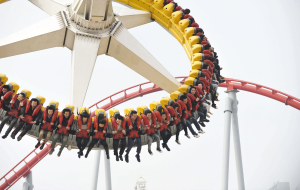
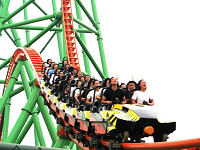
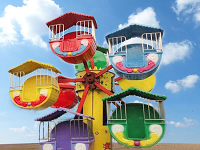
(3) Model of Wu Culture Park The model of Wu Culture Park is to use its own profound cultural heritage to tap local cultural factors.
The Wu Cultural Park model succeeds in mining local culture. Wu Culture Park is its typical representative. Relying on the Wu Studies Research Institute, it explores the traditional local culture of Wu State, such as architecture, food, song and dance, sericulture, textiles, water conservancy, boat bridges, etc. to attract tourists.
(4) Since the 21st century, especially since 2010, Chinese water parks have entered the track of rapid and large-scale development. At present, there are more than 600 large and medium-sized water parks in China. More than 80% have been completed and operated since 2010.
Large and medium-sized water parks are often combined with theme parks, tourist attractions, hot spring hotels, sports facilities, urban complexes and even performing arts to form water entertainment, cultural industries, creative industries, media industries, real estate and tourism and vacations in one area. Constantly cluster and agglomerate.
From the current point of view, water parks are relatively popular as a supporting facility for theme parks, tourist attractions and resorts, accounting for more than 50% of the total of large and medium-sized water parks. While other forms of supporting facilities, such as urban supporting facilities and complex supporting facilities, although there are not many at present, the development trend is very surprising.
At the same time, the traditional water parks with relatively simple functions have also begun to gradually diversify their industries and business directions, transforming into comprehensive tourism, vacation and leisure complexes.
(5) Fifth pole model. This model actually refers to the business model of most other theme parks in my country: the model of simply closing the door to collect tickets.

